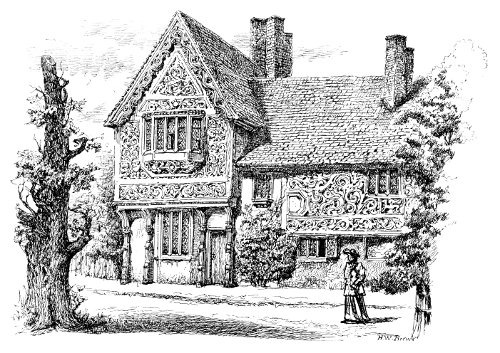THE GIRL'S OWNPAPER

| Vol. XX.—No. 992.] | DECEMBER 31, 1898. | [Price One Penny. |
[Transcriber's Note: This Table of Contents was not present in the original.]
OLD ENGLISH COTTAGE HOMES.
ABOUT PEGGY SAVILLE.
GIRLS AS I HAVE KNOWN THEM.
"OUR HERO."
FROCKS FOR TO-MORROW.
OUR PROSPECTUS PUZZLE REPORT.
IN THE TWILIGHT SIDE BY SIDE.
"SISTER WARWICK": A STORY OF INFLUENCE.
GUS.
ANSWERS TO CORRESPONDENTS.
OUR PUZZLE POEMS.
OUR SUPPLEMENT STORY COMPETITION.
OLD ENGLISH COTTAGE HOMES;
OR,
VILLAGE ARCHITECTURE OF BYGONE TIMES.

All rights reserved.]
PART III.
We have already pointed out the simplicityof outline observable in old English cottages,and the absence of exaggeration and that disagreeablefussiness brought about by toomuch striving after the picturesque. It mustnot, however, from this be concluded thatancient village buildings are always plain anddo not at times possess elegant ornamentationand graceful details.
The general outline, however, is alwayssimple and quiet, for, as will be seen by theexamples we give (two of the most elaboratecottages in England), the roof lines are verylittle broken up or varied.
The first of these buildings is at Clare inSuffolk, and the second is at Newport inEssex, the latter being one of the richestcounties in England for cottage architecture,many of its villages retaining quite a mediævalaspect down to the present time.
We will now say a few words upon themethods of applying ornamental detail tocottages adopted in mediæval times, and weshall commence with those structures erectedin "Post-and-pan" construction. We trustthat our readers have not forgotten whatis meant by the ugly-sounding expression"Post-and-pan," and regret that we are quiteunable to discover or invent some moreelegant name for this description of building.Some years back a number of architects and{210}archæologists w